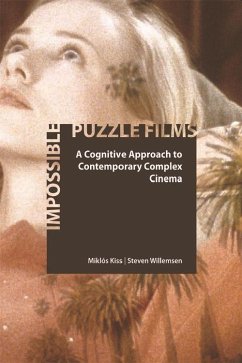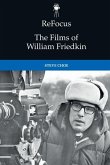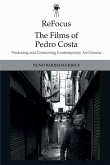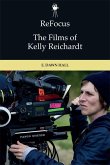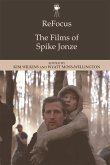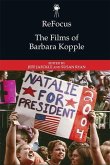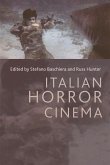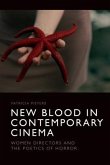Miklos Kiss (Assistant Professor in Film and Univers Media Studies, Steven Willemsen (University of Gr Junior Lecturer in Film Studies
Impossible Puzzle Films
A Cognitive Approach to Contemporary Complex Cinema
Miklos Kiss (Assistant Professor in Film and Univers Media Studies, Steven Willemsen (University of Gr Junior Lecturer in Film Studies
Impossible Puzzle Films
A Cognitive Approach to Contemporary Complex Cinema
- Broschiertes Buch
- Merkliste
- Auf die Merkliste
- Bewerten Bewerten
- Teilen
- Produkt teilen
- Produkterinnerung
- Produkterinnerung
By blending film studies and cognitive sciences, Miklà s Kiss and Steven Willemsenâ s study on Impossible Puzzle Films looks into the relation between complex storytelling and the mind.
Andere Kunden interessierten sich auch für
![Refocus: The Films of William Friedkin Refocus: The Films of William Friedkin]() Steve ChoeRefocus: The Films of William Friedkin87,99 €
Steve ChoeRefocus: The Films of William Friedkin87,99 €![Refocus: The Films of Pedro Costa Refocus: The Films of Pedro Costa]() Nuno Barradas JorgeRefocus: The Films of Pedro Costa30,99 €
Nuno Barradas JorgeRefocus: The Films of Pedro Costa30,99 €![Refocus: The Films of Kelly Reichardt Refocus: The Films of Kelly Reichardt]() E. Dawn HallRefocus: The Films of Kelly Reichardt30,99 €
E. Dawn HallRefocus: The Films of Kelly Reichardt30,99 €![Refocus: The Films of Spike Jonze Refocus: The Films of Spike Jonze]() Refocus: The Films of Spike Jonze38,99 €
Refocus: The Films of Spike Jonze38,99 €![Refocus: The Films of Barbara Kopple Refocus: The Films of Barbara Kopple]() Refocus: The Films of Barbara Kopple30,99 €
Refocus: The Films of Barbara Kopple30,99 €![Italian Horror Cinema Italian Horror Cinema]() Italian Horror Cinema38,99 €
Italian Horror Cinema38,99 €![New Blood in Contemporary Cinema New Blood in Contemporary Cinema]() Prof. dr. Patricia Pisters (University of Amsterdam Professor)New Blood in Contemporary Cinema30,99 €
Prof. dr. Patricia Pisters (University of Amsterdam Professor)New Blood in Contemporary Cinema30,99 €-
-
-
By blending film studies and cognitive sciences, Miklà s Kiss and Steven Willemsenâ s study on Impossible Puzzle Films looks into the relation between complex storytelling and the mind.
Produktdetails
- Produktdetails
- Verlag: Edinburgh University Press
- Seitenzahl: 240
- Erscheinungstermin: 22. Februar 2018
- Englisch
- Abmessung: 156mm x 234mm x 14mm
- Gewicht: 384g
- ISBN-13: 9781474431972
- ISBN-10: 1474431976
- Artikelnr.: 49094046
- Herstellerkennzeichnung
- Libri GmbH
- Europaallee 1
- 36244 Bad Hersfeld
- gpsr@libri.de
- Verlag: Edinburgh University Press
- Seitenzahl: 240
- Erscheinungstermin: 22. Februar 2018
- Englisch
- Abmessung: 156mm x 234mm x 14mm
- Gewicht: 384g
- ISBN-13: 9781474431972
- ISBN-10: 1474431976
- Artikelnr.: 49094046
- Herstellerkennzeichnung
- Libri GmbH
- Europaallee 1
- 36244 Bad Hersfeld
- gpsr@libri.de
Miklós Kiss is Assistant Professor in Film and Media Studies at the University of Groningen, the Netherlands. His research focuses on contemporary audiovisual media, intersecting the fields of narrative and cognitive film theories.
Acknowledgements
Preface
1. Contemporary Complex Cinema
1.1 Complex conditions: the resurgence of narrative complexity
1.2 Complex cinema as brain-candy for the empowered viewer
1.3 Narrative taxonomies: simple, complex, puzzle plots
2. Cognitive Approach to Contemporary Complex Cinema
2.1 Why an (embodied-)cognitive approach?
2.2 Various forms of complexity and their effects on sense making
2.2.1 Problematizing narrative linearity
2.2.2 Complicating narrative structures and ontologies
2.2.3 Under-stimulation and cognitive overload
2.2.4 Contradictions and unreliabilities
2.3 A cognitive approach to classifying complexity
2.3.1 Deceptive unreliability and the twist film
2.3.2 Disorienting but solvable puzzle films
2.3.3 Impossible puzzle films
3. Narrative Complexity and Dissonant Cognitions
3.1 The concept of cognitive dissonance
3.2 Cognitions in dissonance: from social psychology to narrative
engagement
3.3 Types of dissonance in narrative comprehension
3.3.1 Narrative incongruities
3.3.2 Narrative impossibilities
3.4 Cognitive access to impossible storyworlds: immersed and reflected
operations
3.5 'Impossibilities' and embodied cognition
3.5.1 Disrupting viewers' reliance on image schemas by perceptual
impossibility
3.5.2 Disrupting viewers' reliance on image schemas by formal impossibility
4. Taming Dissonance: Cognitive Operations and Interpretive Strategies
4.1 Cognitive dissonance versus narrative coherence
4.2. Reducing dissonance: interpretation and naturalization
4.2.1 Foregrounding
4.2.2 Narrating agency and authorship
4.2.3 Artefact emotions and metareflexive appreciation
4.2.4 Interpretation as dissonance reduction
4.3 Coping with dissonance: frame-switches and poetic and aesthetic
readings
4.4 Frame-switching as hermeneutic play in impossible puzzle films
4.4.1 Switching between narrative and symbolical readings: Enemy and
Mulholland Drive
4.4.2 Cognitive hesitation and the fantastic
5. Impossible Puzzle Films: Between Art-Cinema and (Post-) Classical
Narration
5.1 From art-cinema to puzzle films
5.1.1 Art-cinema as a narrative mode
5.1.2 Dissonance in modernist art-cinema
5.1.3 Art-cinema as a cognitive reception frame
5.1.4 Narrative complexity and meaning-making in art-cinema
5.2 Impossible puzzle films and (post-)classical narration
5.2.1 High degree of tellability
5.2.2 Identification with goal-oriented characters
5.2.3 Strong reliance on classical genre elements
5.2.4 Adherence to classical narrative cohesion devices
5.2.5 Inclusion of quasi-rational frames of naturalization
6. Wallowing in Dissonance: The Attractiveness of Impossible Puzzles
6.1 Hermeneutic play and interpretive multiplicity
6.2 Orientation, navigation, mapping
6.3 Game logic and the fascination in failure
6.4 Effort justification
6.5 Diegetization of decoupling
6.6 Fascination in infinity
6.7 Destabilized ontological certainty
6.8. Eudaimonic motivations and intrinsic needs
References
Filmography
Preface
1. Contemporary Complex Cinema
1.1 Complex conditions: the resurgence of narrative complexity
1.2 Complex cinema as brain-candy for the empowered viewer
1.3 Narrative taxonomies: simple, complex, puzzle plots
2. Cognitive Approach to Contemporary Complex Cinema
2.1 Why an (embodied-)cognitive approach?
2.2 Various forms of complexity and their effects on sense making
2.2.1 Problematizing narrative linearity
2.2.2 Complicating narrative structures and ontologies
2.2.3 Under-stimulation and cognitive overload
2.2.4 Contradictions and unreliabilities
2.3 A cognitive approach to classifying complexity
2.3.1 Deceptive unreliability and the twist film
2.3.2 Disorienting but solvable puzzle films
2.3.3 Impossible puzzle films
3. Narrative Complexity and Dissonant Cognitions
3.1 The concept of cognitive dissonance
3.2 Cognitions in dissonance: from social psychology to narrative
engagement
3.3 Types of dissonance in narrative comprehension
3.3.1 Narrative incongruities
3.3.2 Narrative impossibilities
3.4 Cognitive access to impossible storyworlds: immersed and reflected
operations
3.5 'Impossibilities' and embodied cognition
3.5.1 Disrupting viewers' reliance on image schemas by perceptual
impossibility
3.5.2 Disrupting viewers' reliance on image schemas by formal impossibility
4. Taming Dissonance: Cognitive Operations and Interpretive Strategies
4.1 Cognitive dissonance versus narrative coherence
4.2. Reducing dissonance: interpretation and naturalization
4.2.1 Foregrounding
4.2.2 Narrating agency and authorship
4.2.3 Artefact emotions and metareflexive appreciation
4.2.4 Interpretation as dissonance reduction
4.3 Coping with dissonance: frame-switches and poetic and aesthetic
readings
4.4 Frame-switching as hermeneutic play in impossible puzzle films
4.4.1 Switching between narrative and symbolical readings: Enemy and
Mulholland Drive
4.4.2 Cognitive hesitation and the fantastic
5. Impossible Puzzle Films: Between Art-Cinema and (Post-) Classical
Narration
5.1 From art-cinema to puzzle films
5.1.1 Art-cinema as a narrative mode
5.1.2 Dissonance in modernist art-cinema
5.1.3 Art-cinema as a cognitive reception frame
5.1.4 Narrative complexity and meaning-making in art-cinema
5.2 Impossible puzzle films and (post-)classical narration
5.2.1 High degree of tellability
5.2.2 Identification with goal-oriented characters
5.2.3 Strong reliance on classical genre elements
5.2.4 Adherence to classical narrative cohesion devices
5.2.5 Inclusion of quasi-rational frames of naturalization
6. Wallowing in Dissonance: The Attractiveness of Impossible Puzzles
6.1 Hermeneutic play and interpretive multiplicity
6.2 Orientation, navigation, mapping
6.3 Game logic and the fascination in failure
6.4 Effort justification
6.5 Diegetization of decoupling
6.6 Fascination in infinity
6.7 Destabilized ontological certainty
6.8. Eudaimonic motivations and intrinsic needs
References
Filmography
Acknowledgements
Preface
1. Contemporary Complex Cinema
1.1 Complex conditions: the resurgence of narrative complexity
1.2 Complex cinema as brain-candy for the empowered viewer
1.3 Narrative taxonomies: simple, complex, puzzle plots
2. Cognitive Approach to Contemporary Complex Cinema
2.1 Why an (embodied-)cognitive approach?
2.2 Various forms of complexity and their effects on sense making
2.2.1 Problematizing narrative linearity
2.2.2 Complicating narrative structures and ontologies
2.2.3 Under-stimulation and cognitive overload
2.2.4 Contradictions and unreliabilities
2.3 A cognitive approach to classifying complexity
2.3.1 Deceptive unreliability and the twist film
2.3.2 Disorienting but solvable puzzle films
2.3.3 Impossible puzzle films
3. Narrative Complexity and Dissonant Cognitions
3.1 The concept of cognitive dissonance
3.2 Cognitions in dissonance: from social psychology to narrative
engagement
3.3 Types of dissonance in narrative comprehension
3.3.1 Narrative incongruities
3.3.2 Narrative impossibilities
3.4 Cognitive access to impossible storyworlds: immersed and reflected
operations
3.5 'Impossibilities' and embodied cognition
3.5.1 Disrupting viewers' reliance on image schemas by perceptual
impossibility
3.5.2 Disrupting viewers' reliance on image schemas by formal impossibility
4. Taming Dissonance: Cognitive Operations and Interpretive Strategies
4.1 Cognitive dissonance versus narrative coherence
4.2. Reducing dissonance: interpretation and naturalization
4.2.1 Foregrounding
4.2.2 Narrating agency and authorship
4.2.3 Artefact emotions and metareflexive appreciation
4.2.4 Interpretation as dissonance reduction
4.3 Coping with dissonance: frame-switches and poetic and aesthetic
readings
4.4 Frame-switching as hermeneutic play in impossible puzzle films
4.4.1 Switching between narrative and symbolical readings: Enemy and
Mulholland Drive
4.4.2 Cognitive hesitation and the fantastic
5. Impossible Puzzle Films: Between Art-Cinema and (Post-) Classical
Narration
5.1 From art-cinema to puzzle films
5.1.1 Art-cinema as a narrative mode
5.1.2 Dissonance in modernist art-cinema
5.1.3 Art-cinema as a cognitive reception frame
5.1.4 Narrative complexity and meaning-making in art-cinema
5.2 Impossible puzzle films and (post-)classical narration
5.2.1 High degree of tellability
5.2.2 Identification with goal-oriented characters
5.2.3 Strong reliance on classical genre elements
5.2.4 Adherence to classical narrative cohesion devices
5.2.5 Inclusion of quasi-rational frames of naturalization
6. Wallowing in Dissonance: The Attractiveness of Impossible Puzzles
6.1 Hermeneutic play and interpretive multiplicity
6.2 Orientation, navigation, mapping
6.3 Game logic and the fascination in failure
6.4 Effort justification
6.5 Diegetization of decoupling
6.6 Fascination in infinity
6.7 Destabilized ontological certainty
6.8. Eudaimonic motivations and intrinsic needs
References
Filmography
Preface
1. Contemporary Complex Cinema
1.1 Complex conditions: the resurgence of narrative complexity
1.2 Complex cinema as brain-candy for the empowered viewer
1.3 Narrative taxonomies: simple, complex, puzzle plots
2. Cognitive Approach to Contemporary Complex Cinema
2.1 Why an (embodied-)cognitive approach?
2.2 Various forms of complexity and their effects on sense making
2.2.1 Problematizing narrative linearity
2.2.2 Complicating narrative structures and ontologies
2.2.3 Under-stimulation and cognitive overload
2.2.4 Contradictions and unreliabilities
2.3 A cognitive approach to classifying complexity
2.3.1 Deceptive unreliability and the twist film
2.3.2 Disorienting but solvable puzzle films
2.3.3 Impossible puzzle films
3. Narrative Complexity and Dissonant Cognitions
3.1 The concept of cognitive dissonance
3.2 Cognitions in dissonance: from social psychology to narrative
engagement
3.3 Types of dissonance in narrative comprehension
3.3.1 Narrative incongruities
3.3.2 Narrative impossibilities
3.4 Cognitive access to impossible storyworlds: immersed and reflected
operations
3.5 'Impossibilities' and embodied cognition
3.5.1 Disrupting viewers' reliance on image schemas by perceptual
impossibility
3.5.2 Disrupting viewers' reliance on image schemas by formal impossibility
4. Taming Dissonance: Cognitive Operations and Interpretive Strategies
4.1 Cognitive dissonance versus narrative coherence
4.2. Reducing dissonance: interpretation and naturalization
4.2.1 Foregrounding
4.2.2 Narrating agency and authorship
4.2.3 Artefact emotions and metareflexive appreciation
4.2.4 Interpretation as dissonance reduction
4.3 Coping with dissonance: frame-switches and poetic and aesthetic
readings
4.4 Frame-switching as hermeneutic play in impossible puzzle films
4.4.1 Switching between narrative and symbolical readings: Enemy and
Mulholland Drive
4.4.2 Cognitive hesitation and the fantastic
5. Impossible Puzzle Films: Between Art-Cinema and (Post-) Classical
Narration
5.1 From art-cinema to puzzle films
5.1.1 Art-cinema as a narrative mode
5.1.2 Dissonance in modernist art-cinema
5.1.3 Art-cinema as a cognitive reception frame
5.1.4 Narrative complexity and meaning-making in art-cinema
5.2 Impossible puzzle films and (post-)classical narration
5.2.1 High degree of tellability
5.2.2 Identification with goal-oriented characters
5.2.3 Strong reliance on classical genre elements
5.2.4 Adherence to classical narrative cohesion devices
5.2.5 Inclusion of quasi-rational frames of naturalization
6. Wallowing in Dissonance: The Attractiveness of Impossible Puzzles
6.1 Hermeneutic play and interpretive multiplicity
6.2 Orientation, navigation, mapping
6.3 Game logic and the fascination in failure
6.4 Effort justification
6.5 Diegetization of decoupling
6.6 Fascination in infinity
6.7 Destabilized ontological certainty
6.8. Eudaimonic motivations and intrinsic needs
References
Filmography

